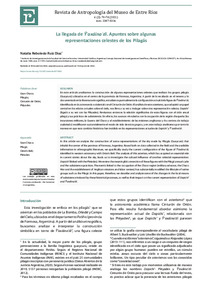Por favor, use este identificador para citar o enlazar este ítem:
https://repositorio.uca.edu.ar/handle/123456789/15155| Título: | La llegada de Ỹʾaxáinaʾdi: apuntes sobre algunas representaciones celestes de los Pilagás | Autor: | Reboledo Ruíz Díaz, Natalia Soledad | Palabras clave: | PILAGAS; PUEBLOS ORIGINARIOS; CINTURON DE ORION; PLEYADES; ETNOGRAFIA; ANTROPOLOGIA; ASTRONOMIA | Fecha de publicación: | 2021 | Editorial: | Secretaría de Cultura del Gobierno de Entre Ríos | Cita: | Reboledo Ruíz Díaz, N. S. La llegada de Ỹʾaxáinaʾdi: apuntes sobre algunas representaciones celestes de los Pilagás [en línea]. Revista de Antropología del Museo de Entre Ríos. 2021, 6 (2). Disponible en: https://repositorio.uca.edu.ar/handle/123456789/15155 | Resumen: | Resumen: En este artículo analizamos la construcción de algunas representaciones celestes que realizan los grupos pilagás (Guaycurú) ubicados en el centro de la provincia de Formosa, Argentina. A partir de lo recabado en el terreno y lo documentado en la literatura etnográfica, estudiamos puntualmente la configuración actual de la figura de Ỹʾaxáinaʾdi, identificada en la astronomía occidental con el Cinturón de Orión. El análisis de este asterismo, que adquirió un papel central en los relatos actuales sobre el cielo, nos lleva a su vez a indagar sobre otra representación celeste, Dapichiʾ (ligado a su vez con las Pléyades). Revisamos entonces la relación significativa de estas figuras con el ciclo anual pilagá y sus prácticas de subsistencia. En efecto, los sucesos vinculados con la ocupación de la región chaqueña (las incursiones militares, la Guerra del Chaco y el establecimiento de las misiones anglicanas y los centros de trabajo asalariado) modificaron sustancialmente el modo de vida de estos grupos, y en este trabajo analizamos por tanto la manera en que esos cambios históricos han incidido en las representaciones actuales de Dapichiʾ y Ỹʾaxáinaʾdi. | Tabla de contenidos: | Abstract: In this article we analyze the construction of some representations of the sky made by Pilagás (Guaycurú) that inhabit the center of the province of Formosa, Argentina. Based both on data collected in the field and the available information in ethnographic literature, we specifically study the current configuration of the figure of Ỹʾaxáinaʾdi, identified in western astronomy with Orion’s Belt. The analysis of this asterism, which has acquired an essential role in current stories about the sky, leads us to investigate the cultural influence of another celestial representation: Dapichiʾ (linked with the Pleiades). We review the meaningful connection of these figures with the Pilagá annual cycle and the subsistence practices. The events linked to the occupation of the Chaco region (military advance, the Chaco War and the establishment of Anglican missions and labor centers) has substantially modified the lifestyle of native groups such as the Pilagá. In this paper, therefore, we describe and analyze some of the changes in the local means of subsistence induced by these historical processes, as well as their impact on the current representation of Dapichiʾ and Ỹʾaxáinaʾdi. | Cobertura Espacial: | Formosa (Argentina : Provincia) | URI: | https://repositorio.uca.edu.ar/handle/123456789/15155 | ISSN: | 2347-033x (online) | Disciplina: | CIENCIAS SOCIALES | Derechos: | Acceso abierto | Fuente: | Revista de Antropología del Museo de Entre Ríos Vol.6, No.2., 2021 |
| Aparece en las colecciones: | Artículos |
Ficheros en este ítem:
| Fichero | Descripción | Tamaño | Formato | |
|---|---|---|---|---|
| llegada-yaxaina-apuntes.pdf | 283,56 kB | Adobe PDF |  Visualizar/Abrir |
Visualizaciones de página(s)
68
comprobado en 27-abr-2024
Descarga(s)
29
comprobado en 27-abr-2024
Google ScholarTM
Ver en Google Scholar
Este ítem está sujeto a una Licencia Creative Commons

